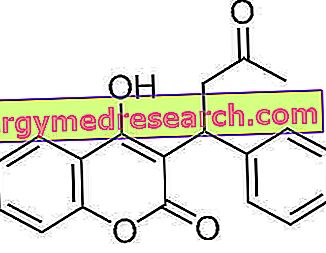Generality
Warfarin - an active ingredient in the registered specialty Coumadin ® - is an oral anticoagulant taken to "thin the blood" and prevent clots from forming inside the circulation.
In Italy coumadin can be purchased in common pharmacies upon presentation of a regular medical prescription; it is available in 5 mg circular tablets, which can be divided into 2 or 4 parts.
Insights
Indications Taking and dosage Diet Side effects and precautions Coumadin: do you know the drug and how do you use it? Take the QuizIndications of Warfarin

Warfarin: Chemical Structure
Coumadin is used in a wide range of diseases to prevent thromboembolic episodes. Let us recall, briefly, that a thrombus is a clot ("a lump" of blood) formed within the blood circulation, while the embolism appears, for example, when a fragment of thrombus obstructs a blood vessel (the embolus, in in this case, it is the piece of lump that circulates in the blood stream). The chances of this happening are greater when there is a slowdown in circulation, for example due to prolonged immobility in bed.
Since the clots are called thrombi, their formation is called thrombosis. The most feared consequences of thrombosis are acute myocardial infarction, stroke, limb ischemia up to gangrene and mesenteric infarction.
Main indications of coumadin
- ATRIAL FIBRILLATION: the heart does not beat in a coordinated way and clots (thrombi) can form inside it
- DEEP VENOUS THROMBOSIS: in this disease the risk of forming clots (thrombi) inside a vein is very high; the clot can then break, be pushed to the heart by blood and from there to the lungs where it causes pulmonary embolism
- CARDIACAL VALVE PROSTHESES: in patients who have had surgical replacement of the heart valves clots can form on the surface of these new valves, with an increased risk of heart attack and stroke
One of the main therapeutic indications of coumadin is deep vein thrombosis, which leads to the formation of thrombi in the veins of the lower limbs, especially after a long immobility. In most cases, the thrombus dissolves spontaneously, but it can happen that they break and that the generated fragments (emboli) are pushed by the blood along the circulatory stream. These fragments are carried by the bloodstream, in larger and larger vessels, up to the heart, which in turn pushes them into the arteries of the lungs. Here, the blood vessels shrink again and the clots stop causing a potentially lethal obstruction - called pulmonary embolism - which can manifest itself with symptoms such as shortness of breath, cough, cyanosis and chest pain.
Coumadin is also used by patients with atrial fibrillation and those carrying artificial heart valves, such as prophylaxis of cardiac infarction. Furthermore, the drug is used in the prevention of reinfarction and thrombosis in patients undergoing particular surgical procedures and in those suffering from antiphospholipid syndrome.
The plasma half-life of warfarin is around 36 hours. The drug is metabolized by the liver and excreted in the urine. Some coagulation factors produced by the liver (II, VII, IX and X) require the presence of vitamin K to be active. The coumadin acts preventing the synthesis from scratch of these factors, while it is not active towards those already formed; for this reason the peak of the effects is not observed before two or three days.
Diet and coumadin »



